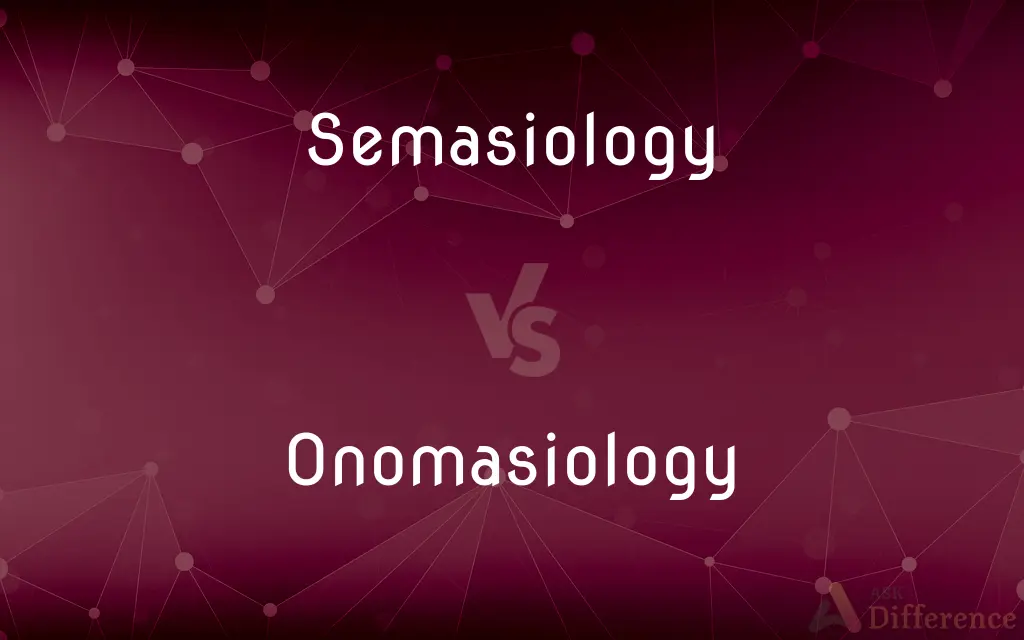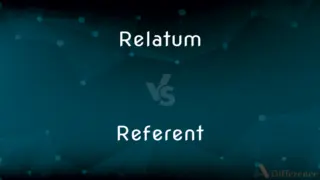Semasiology vs. Onomasiology — What's the Difference?
Edited by Tayyaba Rehman — By Maham Liaqat — Updated on March 26, 2024
Semasiology studies the meanings of words and their development, focusing on how one form can have multiple meanings. Onomasiology, on the other hand, explores how different forms can express the same concept or object.

Difference Between Semasiology and Onomasiology
Table of Contents
ADVERTISEMENT
Key Differences
Semasiology delves into the realm of linguistics by examining the evolution and range of meanings that a single word can encompass. It investigates how words acquire multiple interpretations over time, reflecting changes in culture and societal norms. Onomasiology, conversely, approaches language from the perspective of concepts or objects, analyzing the variety of expressions or terms used to denote the same idea across different languages or within the same language over time.
In semasiology, the emphasis is on semantic shifts—a word's ability to signify different things in different contexts. This branch of linguistics provides insights into the fluidity of language and the dynamic nature of meaning. Onomasiology, while, focuses on lexical variation and synonymy, highlighting how languages offer multiple lexical options to express the same concept, which can illuminate the cultural and historical influences on language.
Semasiology is particularly interested in polysemy and homonymy, where a single form (word) has multiple related or unrelated meanings. This interest underscores the complexity of linguistic expressions and the cognitive processes involved in understanding context. Onomasiology, in contrast, is fascinated by the concept of lexical fields and the linguistic economy, showing how languages manage the balance between lexical richness and communicative efficiency.
Researchers in semasiology often analyze linguistic phenomena such as metaphor and metonymy, which play significant roles in the semantic evolution of words. This analysis helps in understanding how abstract concepts are linguistically materialized through the concrete meanings of words. Onomasiology, on the other hand, examines the strategies and mechanisms employed by speakers to coin new terms or borrow from other languages to fill lexical gaps, providing insights into the adaptive and innovative aspects of language.
Both semasiology and onomasiology contribute valuable perspectives to the study of linguistics, offering complementary insights into the nature of language as a means of human expression and communication. While semasiology provides a deep understanding of how meanings evolve and interact within the linguistic system, onomasiology reveals the diversity of linguistic expressions across cultures and times, reflecting the human capacity for creativity and adaptation in language use.
ADVERTISEMENT
Comparison Chart
Focus
Evolution and range of meanings of a single word
Variety of expressions for the same concept
Key Interest
Semantic shifts and meaning development
Lexical variation and synonymy
Analytical Perspective
How one form can have multiple meanings
How different forms can express the same concept
Linguistic Phenomena
Polysemy and homonymy
Lexical fields and linguistic economy
Contribution to Linguistics
Understanding of meaning evolution and context
Insights into cultural and historical influences on language
Compare with Definitions
Semasiology
The study of word meanings and their evolution.
How gay evolved from meaning happy to denoting sexual orientation.
Onomasiology
Studies how different terms can refer to the same concept.
Car, automobile, and motor vehicle.
Semasiology
Analyzes the impact of culture on word meanings.
Freedom holds different connotations in various cultures.
Onomasiology
Examines lexical fields and synonymy.
The various terms for soda across English-speaking regions.
Semasiology
Examines polysemy and homonymy.
Bank can mean the side of a river or a financial institution.
Onomasiology
Focuses on the creation and adaptation of terms for concepts.
Internet was coined to describe a new technology.
Semasiology
Investigates metaphor and metonymy in semantic changes.
The White House metonymically refers to the U.S. administration.
Onomasiology
Analyzes lexical economy and innovation.
The development of neologisms like blog from web log.
Semasiology
Focuses on semantic shifts within a language.
Mouse extended from an animal to a computer device.
Onomasiology
Investigates cross-linguistic lexical variations.
How different languages express the concept of love.
Semasiology
Semasiology (from Greek: σημασία, semasia, "signification") is a discipline of linguistics concerned with the question "what does the word X mean?". It studies the meaning of words regardless how they are pronounced.
Onomasiology
Onomasiology (from Greek: ὀνομάζω onomāzο 'to name', which in turn is from ὄνομα onoma 'name') is a branch of linguistics concerned with the question "how do you express X?" It is in fact most commonly understood as a branch of lexicology, the study of words (although some apply the term also to grammar and conversation). Onomasiology, as a part of lexicology, starts from a concept which is taken to be prior (i.e.
Semasiology
See semantics.
Onomasiology
(linguistics) A branch of lexicology concerned with the names of concepts.
Semasiology
(linguistics) Semantics; a discipline within linguistics concerned with the meaning of a word independent of its phonetic expression.
Semasiology
The science of meanings or sense development (of words); the explanation of the development and changes of the meanings of words; - more commonly referred to as semantics.
Common Curiosities
How do semasiology and onomasiology differ in focus?
Semasiology focuses on the meanings of words and their changes, whereas onomasiology concentrates on the variety of terms used for the same concept.
What is semasiology?
Semasiology is the study of the meanings of words and their development over time.
What is an example of lexical variation in onomasiology?
"Sneakers," "trainers," and "athletic shoes" are all terms used to describe the same type of footwear.
Can semasiology and onomasiology be considered complementary?
Yes, they offer complementary perspectives on the dynamics of language, covering the spectrum from word meanings to lexical diversity.
What is onomasiology?
Onomasiology is the study of how different words or expressions can denote the same concept or object.
Why is semasiology important?
It helps understand how meanings evolve, reflecting changes in society, culture, and technology.
Why is onomasiology important?
It offers insights into the diversity of expression in language and the cultural and historical contexts that influence it.
How does semasiology relate to polysemy?
Semasiology examines polysemy, the phenomenon where a word has multiple related meanings, to understand semantic complexity.
Can you give an example of semantic shift studied in semasiology?
An example is the word "cool," which originally meant low in temperature but now also denotes something fashionable or acceptable.
What role does synonymy play in onomasiology?
Synonymy is central to onomasiology, highlighting how languages have multiple words for the same concept, reflecting linguistic richness.
What is an example of a research area in onomasiology?
Analyzing the variety of terms used across languages to describe natural phenomena, like "aurora."
How does culture impact semasiology and onomasiology?
Culture shapes the meanings of words and the variety of expressions available for concepts, influencing both fields significantly.
How do metaphors influence semasiology?
Metaphors contribute to semantic shifts by allowing words to acquire new meanings based on analogical reasoning.
What does lexical economy mean in onomasiology?
Lexical economy refers to the balance between the need for linguistic efficiency and the desire for expressive richness.
What is an example of a study topic in semasiology?
Investigating how the term "virus" has expanded from medical to technological contexts (e.g., computer viruses).
Share Your Discovery

Previous Comparison
Overlay vs. Underlay
Next Comparison
Relatum vs. ReferentAuthor Spotlight
Written by
Maham LiaqatEdited by
Tayyaba RehmanTayyaba Rehman is a distinguished writer, currently serving as a primary contributor to askdifference.com. As a researcher in semantics and etymology, Tayyaba's passion for the complexity of languages and their distinctions has found a perfect home on the platform. Tayyaba delves into the intricacies of language, distinguishing between commonly confused words and phrases, thereby providing clarity for readers worldwide.














































